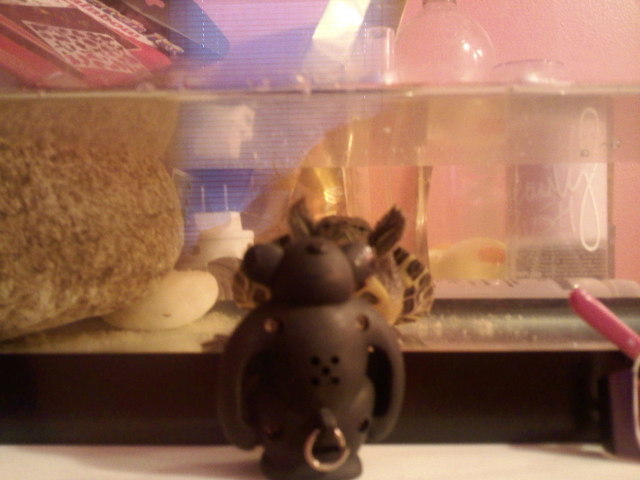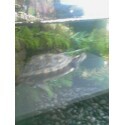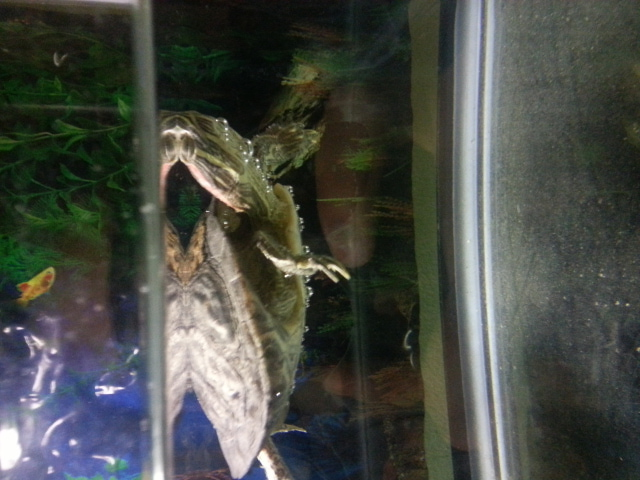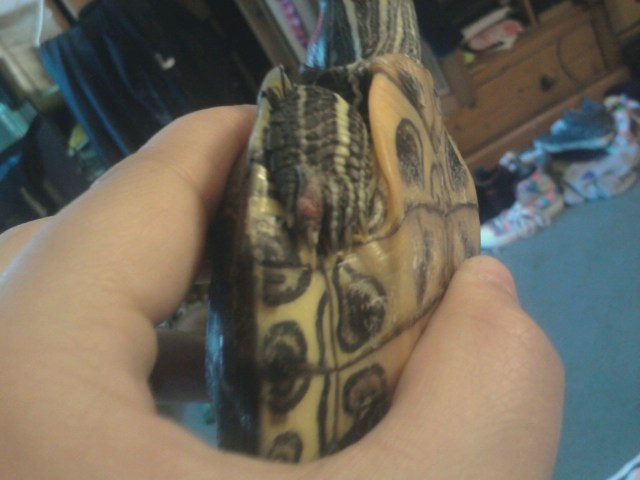QuestionQUESTION: I brought home two baby common map turtles (4 inches long)almost a month ago. I picked out the two healthiest ones, I had thought, as many others had injuries on their front legs due to rough transport to the pet store(so I was told). One of the two, the female, died yesterday without warning. I'll list anything I can think of that could be useful in determining cause of death.
They have a 50-gallon setup (about 27 gallons of water)with a basking area(wooden)on one end(regular heat bulb), a floater(wooden) in the middle, and a shallow area(pile of rocks)on the far end. They also have two large submersible filters on either end, and a heater set at 72F. I don't use UVB light because they get plenty of natural light in the place their tank is set up.
When I got them, both had thin bits of their shell here and there that looked like they were getting ready to peel off. I took this as normal shedding (I've never owned turtles, but I have a friend that I frequently live with and they have four red eared sliders. I've spent lots of time watching and feeding them, as well as cleaning and setting up their tank and equiptment. I base alot of my techniques on my experience with them.)
A couple weeks after I brought them home, I noticed that both had seemingly abnormal spots on their shells. The female had a hard grey indent on the underside of her shell about the size of an "O" on a keyboard. The male had a similar spot on top of his shell, but less of an indent and more of a rough grey spot. The spots didn't seem to be expanding or getting any worse, so I didn't pay much attention to them, thinking I'd look it up soon just to see what it could be, but not thinking that it was a threat to their health.
Four days ago I went in to check on them and to turn the basking light off, when I was shocked to discover the water had gone from crystal clear earlier that day to filthy brown, with slimy material floating in the water and clogging both filters. I removed the turtles for the night and the tank and everything in it got srubbed the next day. We never found out what had caused the cloudy water. A screen got put over the tank to keep out unwelcome filth from above, though we highly doubted that had been the case. I am skeptical as to the turtles being the cause of it, because one or even two tiny turts could not manage (in my opinion) to trash all 27-gallons so quickly and so thoroughly.
Yesterday, I was watching the turtles and they seemed fine. The male was underwater near the basking area, and the female was on the pile of rocks with her head poking out of the water. Less than ten minutes later, the female, having crawled up into the basking area, started having spasms. All four legs recoiled and shot back out, repetitively, as if she were having a seizure. Her head pointed straight up, and she made gasping motions. I picked her up, fearing she might fall in the water and drown, and not knowing what was wrong. She went limp in my hands, just to awake moments later and repeat the "seizure." This happened at least five times. She foamed at the mouth and urinated as well. When the spasms stopped, I put her in a small plastic box and moved the heater over her, and added a little water so she wouldn't dry out. A few hours later, she seemd much better, though still weak, crawling around the box and even trying to scale its sides. However, by the fourth hour, she had died.
I have no idea what killed her, hence the history. Also, the male seems perfectly fine (I've been monitoring him closely). We have been feeding them commercial pellets and mealworms. I don't know what other info to add. I want to find out why she died, and if there is a risk that the male might be at risk. Also, do you know what his grey spot (and hers) could be?
ANSWER: Hi Michelle,
A 4" map isn't a baby; I'm guessing the pet store told you that because they seem to have a thing about passing off turtles as babies. If you're able to actually sex one as male, they're mature or just sub-adult, since hatchlings and juveniles can't be sexed (they all look female). A male won't get bigger than about 6", but a bigger female could reach 10" or so.
A 50 gallon tank isn't big enough for two 4" turtles that are still growing. You should realistically get them a tank big enough for full adult size, and for two I'd get 150 gallons, although 125 would work. For a tank of that size, you need a really good external canister filter. My guess is that the spot is shell rot related to water quality--too small of a tank, too much waste, not enough filtration. Most skin and shell issues in turtles can be prevented by having plenty of room and really good filtration.
You should check to see what the basking temperature is--it should be about 88-90 degrees, measured on the basking platform directly under the basking bulb. Don't guess, because it may be quite a bit different from what you think. You also need to provide UVB unless the turtles are actually outside. UVB won't penetrate through window glass. My recommendation for UVB is either the Reptisun 10.0 or a combo bulb (heat/UVB; ZooMed Powersun). See http://russiantortoise.org/uvb.htm.
I don't know what caused the filter problem you described, but if the filters clogged for any reason, it wouldn't take long for two mature turtles in a small tank to dirty the water up, and that's most likely what happened.
I also don't know what caused the female to die. That almost sounds like a toxic reaction, but if the other turtle is OK that's not likely to be it. Without a necropsy it's almost impossible to say unless you saw other symptoms. I would, however, be very concerned that the other turtles at the pet shop were in poor shape. There really is no excuse for "rough transport" of any animal. I've shipped hatchling (2") tortoises all over the US without incident. It's a matter of packing and shipping them properly. If the turtles were that bashed up (and the injuries not due to aggression from other turtles, which is also a possibility if they were kept in crowded conditions), that means that the dealer doesn't care enough about the animals to make sure they're shipped correctly, and that in turn means that they may not have been taking very good care of them prior to shipping. It's an unfortunate truth that some turtle dealers don't really care that much about the animals they sell, so health isn't a priority. Keep a good watch on your remaining turtle. If you see any suspicious symptoms at all, you should take him to a good reptile vet.
The small area on the shell could be healed shell rot. At this point I would just watch it for any changes in size or consistency (softness, oozing, redness, odor, etc.), and make the tank changes I suggested above.
Here are some links to more detailed information on setting up a tank, filtration, etc., as well as specific care information for map turtles, including diet suggestions. Post back if anything is unclear or if you have more questions.
http://www.chelonia.org/articles/graptemyscare.htm
http://www.austinsturtlepage.com/Care/caresheet-northern_map.htm
http://www.austinsturtlepage.com/Care/care.htm
http://www.austinsturtlepage.com/Care/waterquality.htm
http://www.austinsturtlepage.com/Care/housing.htm
---------- FOLLOW-UP ----------
QUESTION: Thank you very much. The remaining turtle seems fine, and the spot on his shell is unchanged. There have been no further problems with the water, so that remains a mystery. We're definitely going to get a bigger tank as he grows, but the 50 gallon is the best we have at the moment. Also, I took the temperature at the center of the basking spot, and it's 100F. I'm not too concerned because he can bask at the edges, or get in the water or on the center platform if he gets too hot. Also, I upped the water temp. to 76F because it was recomended to me by a friend. Apart from getting a UV lamp, does that all seem okay?
AnswerYou need to raise the basking bulb. 100 degrees is too hot, and if it's too hot the turtle may end up spending too much time in the water and develop shell rot. The water temp is OK, but don't raise it higher because you don't want the water to be too warm. There should be 10 to 15 degrees difference in temperature between water and basking area.
Make sure you do regular partial water changes. Since you can't upgrade the tank right now, you might consider getting an external canister filter rated at 200+ gph to help keep the water really clean. If it's rated high enough, you can use it when you can get a bigger tank.
Other than that, the UVB bulb, and getting more variety into the diet, things look OK!

 tuff turtle
Question
Ichabod
hi, my red ear is a little over a year
tuff turtle
Question
Ichabod
hi, my red ear is a little over a year
 Golden spots on shell
QuestionQUESTION: I have 2 red ear sliders & 2 painted
Golden spots on shell
QuestionQUESTION: I have 2 red ear sliders & 2 painted
 I am pretty sure the box turtle has URI
Question
What a Beauty!
Hi Jamie,
My kids found
I am pretty sure the box turtle has URI
Question
What a Beauty!
Hi Jamie,
My kids found
 turtle sleeping
Question
turtle in water turtle in water
N
turtle sleeping
Question
turtle in water turtle in water
N
 Turtle skin problem
Question
Paw bleeding
My turtle Squirtle is a Red Ear S
Turtle skin problem
Question
Paw bleeding
My turtle Squirtle is a Red Ear S